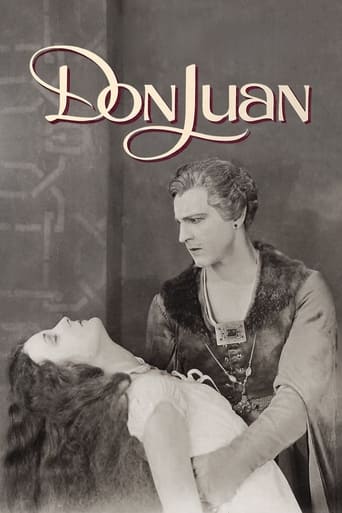JohnHowardReid
Myrna Loy commenced in the chorus in M-G-M's "Pretty Ladies" (1925), but soon graduated to featured roles in Warner Bros "B" efforts, while continuing to grace unbilled or small roles in "A" productions such as the magnificent "Don Juan" (1926) (formerly available on a superb VHS tape) in which she plays Lucrezia Borgia's maid. "Don Juan", of course, was the prestige movie that ushered in the sound era for motion pictures. While there was no spoken dialogue, the whole film was accompanied by a rousing pre-recorded orchestral score, plus effective sound effects. John Barrymore - here in his prime - played the title character with such panache, he overwhelmed most of the cast - including not only Myrna Loy, but just about everyone else.There were, however, just five exceptions. The five who stood up to Barrymore and were not overwhelmed in his presence, were Mary Astor's lovely heroine, Estelle Taylor's treacherous Lucrezia, Warner Oland's Cesare Borgia and Montague Love's villainous Count Donati.
MissSimonetta
This is a fun film. It has a charismatic lead in John Barrymore, a deliciously evil villains in Estelle Taylor and Montagu Love, and a beautiful young Mary Astor as the ingénue who cures Don Juan of his skirt chasing ways. There's lots of ardent love scenes and swashbuckling action a la Douglas Fairbanks.The sets and costumes are strange, a bizarre mix of 16th century fashion and art deco. The women sport kiss curls and cupid bow mouths. Modern viewers unused to a thing known as historical context will no doubt laugh at the heavily made up men (especially Don Juan's sidekick; he seems to be wearing more lipstick than Estelle Taylor.) All in all, a good time for silent film fans.
OutsideHollywoodLand
Released in 1927, this silent classic stars the iconic John Barrymore as the legendary lover and Mary Astor as the lithe and lovely Adriana. Set against the power struggles and intrigue of the House of Borgia's, Don Juan romps about, setting all female hearts aflutter. With his faithful servant, Pedrillo, keeping a tight daily schedule, Don Juan manages to fit in a handful of willing lovers throughout the day.The film opens on the Don as a young boy, who witnesses his mother's infidelity and his father's wrath. This episode in Don Juan's early life causes him to view women with little trust, and he seems hell bent in proving to himself that all women are easily won with the right pick-up line.Of course, the virtuous Adriana finally cracks the Don's crusty exterior and he becomes a believer in true love - but not without a stirring fight scene, poisonings, and 191 kisses! A fine supporting cast of Warner Oland, Estelle Taylor, Montagu Love, Myrna Loy, and Willard Louis, together with the experienced direction of Alan Crosland (The Jazz Singer) makes Don Juan a great viewing treat for all cinefile fans.Known as the "Great Profile", John Barrymore's famous face gets displayed to its greatest advantage in one of his most popular film roles. The Barrymore name is part of a family dynasty reaching back four generations, to include stage and film stars such as Lionel, Ethel, and current film star Drew Barrymore.(John's last words on his deathbed) "Die? I should say not, dear fellow. No Barrymore would allow such a conventional thing to happen to him." Mary Astor's Oscar-winning career spanned almost fifty years of silent and talking films. Perhaps best known today for her work as Brigid O'Shaughnessy in John Huston's The Maltese Falcon with Humphrey Bogart and her Academy Award role in The Great Lie, her Adriana opposite Don Juan was the coveted screen pairing of the decade.Mary was never a romantic when it came to her career, however. Of it, she said, "There are five stages in the life of an actor: Who's Mary Astor? Get me Mary Astor. Get me a Mary Astor Type. Get me a young Mary Astor. Who's Mary Astor?" Luckily, we have Don Juan to fully appreciate her, yet again, via late night screenings.
Fisher L. Forrest
Although it may not be too obvious because of all the legendary Roman trappings, this is actually a fancy formula western (Western Europe, that is). The rake-hell gunslinger, uh, swordsman, is changed by the love of a good woman into a law-and-order fighter, who then foils the land-grabbing, or something-grabbing, villains. He then rides off into the sunrise (!)with the lady. Of course, the villains being of the Borgia persuasion, his foiling may be only temporary, but we'll never know, will we. Vigorous sword fighting, not convincingly staged if you know much about fencing, but exciting if you can suspend your disbelief, is part of the mix that makes this an entertaining film. Also, there are lots of lovely ladies and some vigorous scenery chewing as well. When all's said, though, a look at John Barrymore in his mid-prime is the main reason to view DON JUAN. As for this being an important film in the "dawn of sound" process of 1926-1927, that is due to the existence of "sound on disc" to provide the music and sound-effects. First-run theatres of the period usually did the same thing with an orchestra or organ, and a piano equipped with sound-effects "traps". The "sound on disc" made it cheap enough for even small neighbourhood theatres to have sound.



